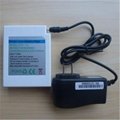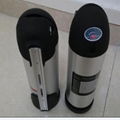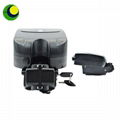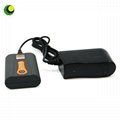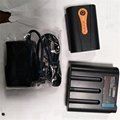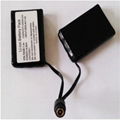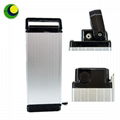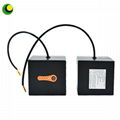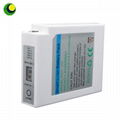| Model: | FCY115 |
|---|---|
| Brand: | FCY |
| Origin: | Made In China |
| Category: | Electronics & Electricity / Battery, Storage Battery & Charger |
| Label: | - |
| Price: |
US $190
/ pc
|
| Min. Order: | 10 pc |
| Last Online:25 Dec, 2019 |
Product Description
1) Lithium-ion (Li-ion) Electric Bike Batteries
2) Emotion Neo City Battery type - electric bike batteries
3) Emotion Neo City Li-ion Electric Bike Battery
------These have become the default battery, capturing over 90% of the market. But to complicate matters, there are many different kinds of Li-ion batteries. On the plus side, Li-ion batteries last longer and generate more power for their weight than other batteries. On the negative side, they are fussy little creatures, and require a genius-inspired smorgasbord of electronic features to prevent them from self-destruction and even catching fire! Of course, none of those are your problems, as the manufacturer will have sorted out the genius side. But like all good things in life, this comes at a price: this battery type is very expensive, and shows little sign of getting cheaper.
Nickel-cadmium (NiCd) Electric Bike Batteries
Weight for weight, nickel-cadmium (NiCd) batteries have more capacity than lead-acid battery, and capacity is an important consideration on an electric bike. However, nickel- cadmium is expensive and cadmium is a nasty pollutant and hard to recycle. On the other hand, NiCd batteries will last longer than lead-acid batteries. But the reality is that because they are so hard to recycle or get rid of safely, NiCd batteries are rapidly becoming a thing of the past. These are also not a good choice of battery type, regardless of price.
Nickel-metal Hydride (NiMh) Electric Bike Batteries
NiMh batteries are somewhat more efficient than NiCd batteries, but they are also more expensive. Most people’s report that NiMh offers little improvement in range over NiCd. On the other hand, they will last longer and are easier to dispose of correctly. Nonetheless, NiMH batteries are also becoming a rarity, because the market place is being taken over by Lithium-ion (Li-ion) batteries.
Lithium-ion Polymer (Li-pol) Electric Bike Batteries
This is a new one, and promises to be no better than the Li-ion battery type in terms of range, weight, or price. However, it can be molded into interesting shapes. They contain no liquid, so they don’t require the heavy protective cases that other batteries need. Also, this absence of free liquid theoretically means that they should be more stable and less vulnerable to problems caused by overcharge, damage or abuse. In general, they seem to be ideal for use in high capacity, low power applications – such as electric bikes.
Given the new trend to make electric bikes look just like other bikes, I am guessing that some creative manufacturers will come up with some radically cool ideas. I wouldn’t rush into buying one of these battery types, however, until they prove themselves in terms of battery life.
Lithium Cobalt (LCO) Electric Bike Batteries
This is another variation on Li-ion. It’s a relatively new kid on the block, and its proponents claim it has much higher energy density than other lithium batteries, so that it offers optimum power in a light, compact package. For example it is used in Optibikes, and the manufacturers claim “no other electric bike can go as far as an Optibike, guaranteed”.Yet another one that still has to prove itself, though.

Buying Guides
What are eBike batteries made of?
1.Electric bikes in the world tend to come with either Lithium Ion (Li-Ion) or Lithium Polymer (LiPo) batteries.
2.Because of problems with quality and weight, lead acid batteries are not common in the rest of the world. In Europe, for example, acid lead batteries represent less then one per cent of the total; while 96.5 per cent is taken by Li-Ion and two per cent by LiPo (source: Greenfinder market report).
Specifically, battery packs are made up from many cells: the lead acid ones are similar to those we use on our cars, while the lithium ones use the same technology as mobile phones. Apart from the chemical component inside their cells, the main feature that differentiates lead acid and lithium batteries is their size: the lead ones are heavy and have a short life (200 to 300 charge cycles), while the lithium ones are smaller and can last longer (from 500 to 1,000 charge cycles).
3.The LiPo batteries are a further development of the Li-Ion ones – they are relatively cheap and small in size, but their service charge is unclear and they are quite fragile.
How long will my battery last?
1.That’s a tough one to answer. It depends on the power of the battery (typically 24, 36 or 48V), the power of the bike (limited in the UK to 250W), the bike’s battery management system, and the way you ride. Some bikes allow you to choose different levels of assist to prioritise speed or battery life, which makes predictions of battery life even more difficult.
2.Typically you can expect somewhere between 25 and 70 miles of travel on a single charge of an ebike. If you’re riding hard on full power expect less; manage your battery life well and you could get more.
Where are the batteries placed on an ebike?
The battery’s placement on the bike depends on different factors, especially the shape of the bike’s frame. Most electric city bikes (more than a half) will have the battery mounted on the carrier rack, while mountain bikes usually have them on the down tube.
How much do electric bike batteries cost?
The batteries are the heaviest and the most expensive part of an electric bike.
Technology is advancing fast, so check with your ebike retailer first to ensure that battery isn’t outdated or difficult to replace.
ELECTRIC BIKE BATTERY SIZE - HOW IS IT MEASURED AND WHAT DOES IT MEAN?
1. As a rule of thumb, bigger battery size (capacity) means more distance travelled (range). Therefore, battery capacity is an important specification for an electric bike. Capacity is most often stated in amp hours (Ah). Some manufacturers describe capacity in watt-hours (Wh). In order to compare apples with apples, you will need to divide the watt hours figure by the battery’s voltage (V) (which is also usually stated prominently in the e-bike’s specifications). The majority of modern e-bikes run on 36 volts. As an example, an e-bike with a 36V/400wh system from Bosch has 11.6Ah.
2.What sizes are available? Some manufacturers offer big 17Ah batteries (like our Kalkhoff Agattu). Other e-bikes will have smaller batteries (the light and beautiful Faraday Cortland has just over 7Ah).
In practical terms, a smaller battery is sufficient for those people who use their bikes for shorter rides. Bigger batteries are best for those who have a longer commute, enjoy extended weekend bike outings, or like to use a little more help from the motor. To get better idea of the range you can get from different batteries, have a look at the battery range FAQ.
How long does the battery of my electric bike last?
1.Battery life is calculated in charge cycles. This means it depends on the number of full charges (from 0 to 100%) that they can undergo before their effectiveness gradually diminishes, until they no longer function at all.
2.In theory, an electric bicycle battery can undergo several hundred charge cycles. How much exactly? That depends on the battery type concerned. The way you take care of your battery will also affect its life. For example, if you store your battery somewhere dry and protected from temperature fluctuations, you will keep it longer. In general, with regular use, an electric bike battery becomes less efficient after 3 to 5 years.
3.Each battery type has its own life span
4.E-bike battery life expectancy is mainly determined by the battery type. The most commonly used batteries are:
5.lithium batteries: tend to become widespread and may hold up to 1000 charge cycles, or even more for the latest Lithium Iron Phosphate models
nickel batteries: expect around 500 cycles
lead batteries (on first-generation electric bicycles): expect around 300 cycles
Be careful! This lifetime is a theoretical indication based on manufacturers' estimates.
It may vary according to the battery's build quality. So a bad quality lithium battery runs more risk of stopping working prematurely than a good nickel battery.
Make sure the seller has a minimum two-year guarantee, as established by law. Also be aware of the 'health' of your battery. If you notice that it discharges more quickly after a few months, there is probably a manufacturing defect.
What if a battery reaches its maximum number of charge cycles?
1.The maximum number of charge cycles specified by the manufacturer in fact corresponds to the number of recharging cycles that a battery can theoretically undergo without losing too much efficiency.
2.At the end of the specified number of cycles, its performance will be reduced and it will hold its charge for a shorter time. It is up to you to judge, depending on your use, whether a replacement is necessary or whether you can get by.
-----A battery wears out even if it isn't being used
The energy it has stored escapes gradually: this is called 'self-discharging'. If it remains completely discharged for a long period of time, irreparable damage can occur due to chemical reactions inside the battery. Refer to your battery's user manual for information on what to do if you do not intend to use it for a period of time. Recommendations vary depending on the type of battery.
How to take care of electric bike batteries?
(Charging)
1.Always use the charger as well as the adapter supplied with your battery. It will avoid overcharging and protects the battery against damage due to short circuits.
Let your battery cool before charging it. Also, do not use it directly after recharging.
Never completely drain the battery, but always try charging it to 100%.
If you won't use your bike for prolonged periods of time, make sure to partially charge the battery every few months.
2.Always disconnect the charger from the battery and the network after charging.
Storage
3.Keep your battery in a cool and dry place (preferably between 0 and 20°).
Avoid elevated temperatures and do not leave the battery near a heat source.
(Cleaning)
1.Remember that water and electricity do not match! Before cleaning (as well as before doing any work on your e-bike) always remove the battery.
2.Never use a steam pressure washer when cleaning the battery (or your e-bike).
Never completely immerse the battery in water. Wiping it off with a damp cloth is sufficient.
APPLICATIONS



About US
FCY is one of the high technology firms which devotes to R&D the new energy, mainly engaged in the electronic electrician supporting lithium battery, digital products of lithium battery. Develop, produce and sell three series of Mining military security battery.
Our main products are Ebike battery,battery pack for Rc hobby and Rc airplane,rechargable battery for heating jacket and air-conditional jacket,power bank, UPSwith solar, ect, our main customers are in US, India,span,japan,Hungary,UK, we have 200 workers in factory and our own testing equipments with quality control. Also can be customized proaducts for customers.
The products of FCY have passed the ISO9001, CE, SGS, MSDS, such as UN38.3 authentication.



Customer Service
( 1 ) Communication: We usually replies to emails within 3-4 hours during working time.
( 2 ) Order processing: Most orders are shipped within 3~5 days *except during Holidays and vacation.
( 3 ) After sale support: We will try to help you with any technical/setup issues to our best knowledge
Contact Person
Name;EmilyZhang
Skype:Emily_zhang668

Have any question or request feel free to contact me anytime,thanks

